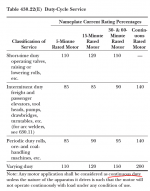Ashu
Member
- Location
- Hunt Valley, USA
- Occupation
- Electrical Engineer
Hello,
NEC defines continuous load as "A load where the maximum current is expected to continue for 3 hours or more." I am struggling here with term "maximum current". I design machines which use oversized Servo Motors to deal with intermittent peak current requirement. These motors actually run at a current about 30% of their rated motor nameplate current. For example, a motor with 98A rated current, draws only 30A. My question is as none of these motors run at maximum current (Which I consider as motor rated current), should these loads be considered as non-continuous duty loads, per NEC's definition? Thank you!
NEC defines continuous load as "A load where the maximum current is expected to continue for 3 hours or more." I am struggling here with term "maximum current". I design machines which use oversized Servo Motors to deal with intermittent peak current requirement. These motors actually run at a current about 30% of their rated motor nameplate current. For example, a motor with 98A rated current, draws only 30A. My question is as none of these motors run at maximum current (Which I consider as motor rated current), should these loads be considered as non-continuous duty loads, per NEC's definition? Thank you!


